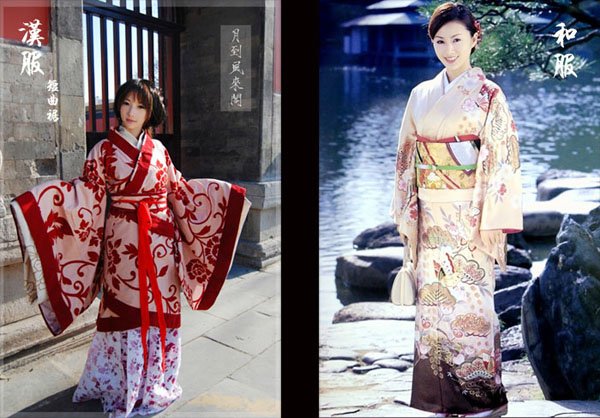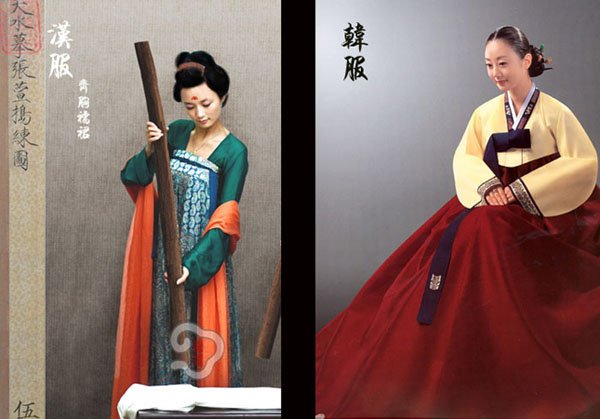
汉服 Hanfu (short 裾 VS) VS 和服比较kimono
Hanfu and Kimono In Japan's Nara period , that is, China's Tang search forDynasty, Japan sent a large number of Tang sent to China to learn Chinese culture and arts, legal system, which also includes the system of clothing. At that time they also imitated the Tang system promulgated the "clothes order." Japan still calls kimono "wufu", meaning clothes from China's Wu area (now Jiangsu and Zhejiang). There is also a Japanese dress dress called "Tang Yi." Although the kimono developed from the Han Dynasty, but after a long period of history, has developed its own ethnic characteristics. For example, the big belt behind the kimono is one of the characteristics of the kimono and also the main symbol of kimono and hanbok. Kimono on clothing, etc. often also have distinctive Japanese national characteristics.
Although the basic style of Japanese kimono comes from the Chinese clothing, the difference between the two can still be seen at a glance. Now the typical representative of the Chinese clothing "Qu Xiu Shen Yi", for example, and kimono comparison is as follows:
1, belt: Han Chinese clothing belt - Bo is a corset, and kimono is a pile of cloth overlay, the waist is thick.
2, sleeves: Chinese clothing wide-sleeved cutting lines soft, and Kimono sleeves lines are straight, sleeves a bit like a blade; other Han's wide sleeves are open, which can be pocket, and the lower part of the kimono cuff is stitched (Probably because of the cold). Han Chinese sleeve length over hand, dress back elbows, kimono sleeves grow to the wrist.
3, clothing 裾: Hanfu clothing more elegant and free, kimono clothing 裾 more formal.
4, clothing edge: Han collar, sleeves, 裾 have clothing edge, and the clothing edge and the main ingredients of different colors, such as with the same color, need to use Jin Dai in the seam and the main material of the seams to indicate the margin. Kimono collar only collar, and the edge of the same materials and materials.
5, neckline: kimono collar good women wrap the neck very tight, Geisha neckline later met a large section of the neck, Han Chinese clothing collar close to the pituitary gland.
6, radians: kimono pursuit of straight line, Hanfu pursuit of the curve, the Han Chinese women's clothing Shen Yi is usually Qu Kui, kimono Xiazhang points four cut, are square. Hanfu straight 裾 shenmianxiazhang points for the twelve, trapezoid; Qu Xi Shen Yi 4 cut also has 6 cut also 12 cut, all trapezoidal.
7, wear: Chinese clothing Shen Yi up and down the division, and then stitched Han costumes Confucian skirt, Confucianism and the Confucianism by the Confucianism. Kimono blouse under the clothes separately. Han clothing free and easy, and the kimono must be worn straight up and down barrel shape to meet their aesthetic standards.

汉服 Hanfu ( waist waist skirt ) VS 韩服Hanbok (North Korea service)search for
[Hanfu and Hanbok (North Korea service)] Kimono main imitation of the Chinese clothing is the deep clothing, and Hanbok (North Korea service) is mainly imitated the Hanfu dress. The main difference hanbok (Korean clothes) and Chinese clothes at: Han Chinese clothing is generally cross collar right of junction , there are buttons down the front of (V-neck), hanbok (Korean clothes) clothing are generally V-neck. Hanbok (North Korea service) dress skirts beam is particularly high, and the hem is very large, fluffy.
The Similarities and Differences Between the Cuttings of Hanban and Kimono, Hanbok (North Korea Service)
In the history of the costumes, some of the Ming Dynasty cross-lapels slightly tilted to the right to give the right collar. (Known as oblique collar clothing, Beijing Opera uniforms for such), is the right half of the film, and because of some right collar cut vertically down due. After clothing, the direct rendering of the collar; hem than the waist, showing trapezoidal. Modern formal TV drama Hanfu show, due to the width of modern cloth, sleeves and more from the arm near the elbow at the next sleeve, before and after the body as a whole piece, the right piece from the "y" shape was cut at the remainder of the piece; unearthed Chinese clothing shows that due to the narrow width of the ancient cloth, and then take more than the sleeve from the shoulder, before and after the body by about two to pick. Kimono predecessor left and right films for the half cloth, around the collar down to the waist buttocks at the end; Straight cut; armpit cuff longitudinal cuffs more than the usual open suture, and with this opening horizontal width Pieces also open the mouth is not sewing. After garments, showing the half-length collar like a straight-collar collar coveralls (ie: does not directly show the cross-Shaped). Wear, take the right phase cover left, showing orthogonal collar shape. Due to straight cut, so the hem is naturally narrow Shoulong narrow (its practice to maintain the source of the ancient Qin costumes of the pre-Qin concept: this is the predecessor of the cross-collar straight-line, wear right and left cover when wearing, showing the orthogonal collar; of course, the predecessor left , The right piece in the half cloth on the basis of each plus more than 10 cm wide pieces and directly show the delivery.) Hanbok (North Korea served) The former left and right about 3/5 pieces of cloth (mostly more than plus half a slit more than 10 cm Wide clothing), clothing directly after the delivery of cross-collar, tail belt and the right chest cloth belt system. Increase the waist limit to below the chest. (Images are from the network)
Source: Baidu.com and http://beijingww.qianlong.com/ Source: reprint
@drotto @OriginalWorks or !originalworks @OriginalWork or !originalwork @steembank #untalented family.
Downvoting a post can decrease pending rewards and make it less visible. Common reasons:
Submit
The @OriginalWorks bot has determined this post by @mzee to be original material and upvoted(1.5%) it!
To call @OriginalWorks, simply reply to any post with @originalworks or !originalworks in your message!
Downvoting a post can decrease pending rewards and make it less visible. Common reasons:
Submit
Hello @mzee
We have given you our still tinnie-winnie upvote!
You have been spotted by @mzee to possess rare gem!
So what can we do than to seal the deal, give you our tiny upvote and celebrate you, for everyone has something to offer.
We welcome you to the #untalented family. Feel free to come around for its a home with us. Flaws allowed, so relegate reservations and play with that beautiful mind of yours, let's tap into more hidden aspects of you. No average, no bum, just awesome you and the best version of YOU is a gift to humanity everytime. Stay awesome!
Join the steemgigs community on discord
https://discord.gg/CGuPyyT
#untalented is a branch of @steemgigs. If you would like to offer your service in building the dreams of other steemians, you can do so under #steemgigs.
However, if you want to experience full blown freedom and grow in confidence about your gifts and talents, share under #untalented.
We aim to create historical moments in the genre of touching lives and you can support us if you desire, by voting on steemgigs for witness. Simply click here
https://steemit.com/~witnesses
and type steemgigs in the first search box.

Just incase you find any level or form of gifts, talents, attempts at out-of-the-boxness, or any steemian low in confidence about their abilities, worth, etc; please don't let it slip emptily by.
Kindly call on me! Simply reply to any such post and add @steem-untalented or #untalented to your reply and i will be there to upvote, acknowledge, strengthen and encourage them.
Downvoting a post can decrease pending rewards and make it less visible. Common reasons:
Submit